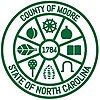
Back Moore County, Noord-Carolina Afrikaans مقاطعة مور (كارولاينا الشمالية) Arabic مقاطعة مور، نورث كارولاينا ARZ Moore County, North Carolina BAR Мор (окръг, Северна Каролина) Bulgarian মোর কাউন্টি, নর্থ ক্যারোলাইনা BPY Moore Gông (North Carolina) CDO Мур (гуо, Къилбаседа Каролина) CE Moore County (kondado sa Tinipong Bansa, North Carolina) CEB Moore County, Gogledd Carolina Welsh
Moore County | |
|---|---|
 Moore County Courthouse in Carthage | |
 Location within the U.S. state of North Carolina | |
 North Carolina's location within the U.S. | |
| Coordinates: 35°19′N 79°29′W / 35.31°N 79.49°W | |
| Country | |
| State | |
| Founded | 1784 |
| Named for | Alfred Moore |
| Seat | Carthage |
| Largest community | Pinehurst |
| Area | |
• Total | 705.69 sq mi (1,827.7 km2) |
| • Land | 697.68 sq mi (1,807.0 km2) |
| • Water | 8.00 sq mi (20.7 km2) 1.13% |
| Population (2020) | |
• Total | 99,727 |
• Estimate (2023) | 106,898 |
| • Density | 142.94/sq mi (55.19/km2) |
| Time zone | UTC−5 (Eastern) |
| • Summer (DST) | UTC−4 (EDT) |
| Congressional district | 9th |
| Website | www |
Moore County is a county located in the U.S. state of North Carolina. As of the 2020 census, its population was 99,727.[1] Its county seat is Carthage and its largest community Pinehurst. It is a border county between the Piedmont and the Atlantic Coastal Plain.
In the early years, the economy was dependent on agriculture and lumber. The lumber business expanded after railroads reached the area, improving access to markets. It lies at the northern edge of the area known as the Sandhills region, and developed resorts in the late 19th century, aided by railroads.
Since the early 21st century, Moore County comprises the Pinehurst-Southern Pines, NC Metropolitan Statistical Area. Moore County is a part of the Fayetteville-Lumberton-Pinehurst, NC Combined Statistical Area, which had an estimated population of 693,299 in 2023, making it the 75th-largest CSA in the United States.[2][3]
- ^ Cite error: The named reference
2020CensusQuickFactswas invoked but never defined (see the help page). - ^ "OMB Bulletin No. 23-01: Revised Delineations of Metropolitan Statistical Areas, Micropolitan Statistical Areas, and Combined Statistical Areas, and Guidance on Uses of the Delineations of These Areas" (PDF). United States Office of Management and Budget. July 21, 2023. Retrieved August 10, 2023.
- ^ "Metropolitan and Micropolitan Statistical Areas Population Totals: 2020-2023". United States Census Bureau, Population Division. March 14, 2024. Retrieved March 15, 2024.

